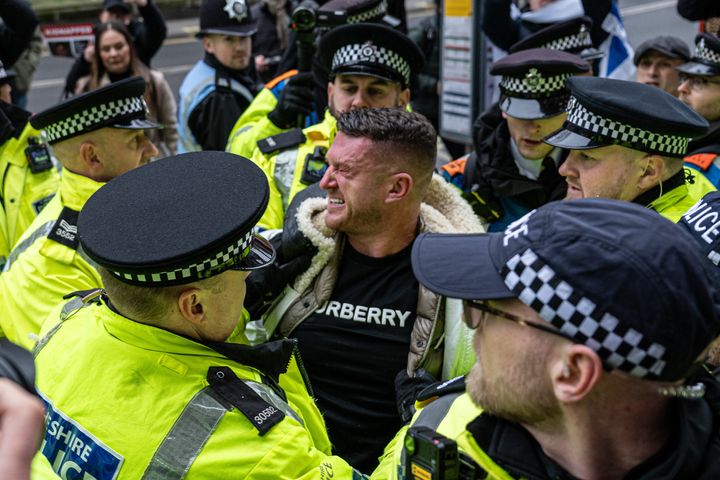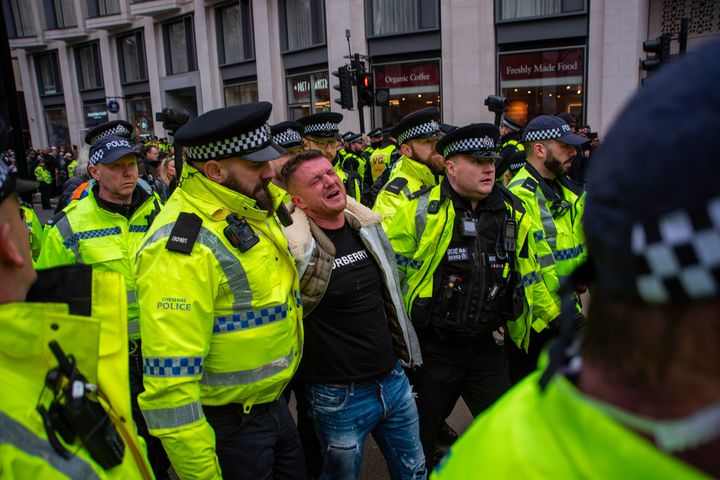
The far-right leader Tommy Robinson was pepper-sprayed and arrested at London’s march against antisemitism over the weekend.
The predominantly peaceful protest against the increase in antisemitism in the UK was attended by up to 60,000 people, including former PM Boris Johnson.
It comes after Palestinian militants Hamas killed an estimated 1,200 people on Israeli soil and took another 240 hostage on 7 October.
Israel subsequently declared war, and has killed an estimated 14,000 people in Gaza through air strikes and a ground invasion since.
This Middle East conflict has caused friction all around the world – but the organisers of the march against antisemitism were keen to keep their demonstration as peaceful as possible.
Robinson, also known by his birth name Stephen Yaxley-Lennon, has long been a figure of division. The anti-Islam activist founded the English Defence League but stepped down in 2013.
He was recently reinstated on X – formerly Twitter – by CEO Elon Musk, having previously been kicked off the platform over alleged hateful conduct.
His arrest subsequently caused a stir on social media, although it wasn’t entirely clear why – so here’s what you need to know.
Why was Tommy Robinson arrested?
Social media clips suggest the tensions between Robinson and officers began when the far-right figure was asked to leave the event while he was in a café.
Robinson reportedly said he had ordered his breakfast, and subsequently refused to leave.
He also said he was present at the march against antisemitism as a journalist – at which point, police started to arrest him.
The Met Police later explained in a statement: “He had refused to comply with a direction to disperse under section 35 of the Antisocial Behaviour, Crime and Policing Act.”
This legislation gives police officers the authority to direct a person to leave a public place (for 48 hours, maximum) if they think the individual will harass, alarm or distress others, or if they’re likely to contribute to “the occurrence in the locality of crime or disorder”.
The Met continued: “We have been in frequent contact with the organisers of the march in recent days.
“They have been clear about their concerns that the man’s attendance, and that of those who were likely to accompany him, would cause fear for other participants. The same view has been voiced by others.
“As a result, he was spoken to and warned on more than one occasion that his continued presence in the area was likely to cause harassment, alarm and distress to others. He was directed to leave the area but refused to do so.”
A Scotland Yard spokesperson later added: “The arrested man resisted as officers attempted to put him in handcuffs.
“He was warned repeatedly before PAVA spray was used.
“Following its use, officers gained control of him and handcuffs were applied.″

What else do we know about the march?
Organisers at the Campaign Against Antisemitism estimate up to 60,000 people attended the march – meaning it was the largest opposition to antisemitism since 1936.
The chief rabbi Sir Ephraim Mirvis said British Jews “will not be intimidated” by antisemitism, and called for more “community cohesion”.
He suggested antisemitism should be called out, recognised as “Jew hatred”, reported, its perpetrators arrested.
He added: “We must teach our children that the superheroes of our society are those who pursue peace and loving kindness, and not those who glorify violence and murder, and we must teach people that they must draw their conclusions from historical facts and not from what they see and hear on social media.”
The police say two people in total were arrested.
The march comes after a reported increase in antisemitism and islamphobia in the UK.
